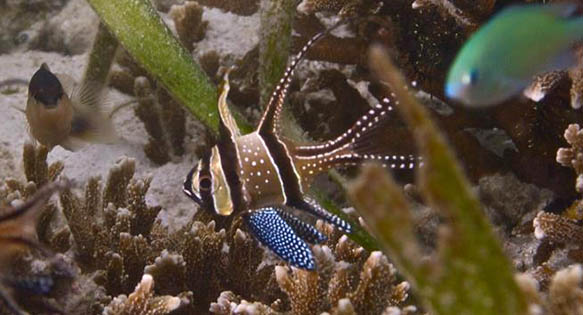The National Marine Fisheries Service (NMFS) is set to publish a proposed rule to list the Banggai Cardinalfish (Pterapogon kauderni) under the Endangered Species Act (ESA) as early as today [12/16/2014].
This news comes upon the completion of an extended status review by NMFS based on a summer 2013 WildEarth Guardians petition to list the species, along with 80 other marine species, under the ESA.
Under the proposed rule, the Banggai Cardinalfish would be listed as “threatened,” meaning there would likely be no immediate changes to trade or commercial activities as a result of the listing. At some point after the species is listed, however, NMFS would probably initiate a rulemaking process under section 4(d) of the ESA.
Black Eye for Aquarium Trade
These so-called 4(d) rules could limit or ban any and all trade in the species, including aquacultured specimens. The final rule should be published within a year, although NMFS does have some latitude to extend the deadline for an additional six months if there is substantial disagreement regarding either the sufficiency or accuracy of the data.
If the Banggai Cardinalfish is listed as threatened under the ESA, it will be the first aquarium species for which the trade bears significant responsibility. In its status review, NMFS found that both habitat destruction and over-utilization for commercial purposes (e.g., the aquarium trade) are the major threats to the species. In the case of most of the other aquarium species listed (or being considered for listing) under the ESA, climate change is considered the primary threat, while extinction risk due to the aquarium trade is considered low.
Signs of Falling Demand for Wild Catch
While NMFS implicates the aquarium trade for more than a decade of unsustainable fishing practices leading to the decline of wild populations, they also note that, in the last few years, fishing pressure has remained static or even decreased.
At the same time, regulation has increased and commercial aquaculture of the species has risen dramatically. In large part, demand for wild-caught Banggai Cardinalfish has been driven down by one aquaculture facility in Southeast Asia supplying one U.S. import/wholesale facility in the U.S. NMFS notes the number of aquacultured Banggai Cardinalfish imported from this one facility is likely sufficient to meet the entire U.S. demand for the species.
Public Comments Invited
NMFS is soliciting public comment, and the public comment period will remain open for 60 days.
During this time, NMFS is specifically seeking comment “[t]o ensure that any final action resulting from this proposed rule…will be as accurate and effective as possible.” Any final regulations regarding the listing of the Banggai Cardinalfish will “take into consideration the comments and any additional information.” As a result of the public comment period and additional review, the final rule may differ from the proposed rule or the proposed rule may be withdrawn.
The 40-page Banggai Cardinalfish status review report is a comprehensive, peer-reviewed report based on the best available science at the time of consideration. Individuals who want to submit comment should make themselves familiar with this document before submitting comments. CORAL Magazine will publish all the relevant links and instructions once the proposed rule is published in the Federal Register. Stay tuned for more analysis of this proposed rule and all other ESA-marine aquarium related actions.
More Information
NOAA’s Listing of Marine Animals Proposed for Protected Status: “Petition to List 81 Marine Species under the ESA”






Whilst the Banggai may be endangered in its natural habitat, what about the invasive fish elsewhere? (http://reefbuilders.com/2011/03/01/invasive-banggai-cardinalfish) . Instead of relying on a expensive breeding project, why can they not be caught elsewhere and relocated back to their natural environment?
Hi, Mark. Thanks for the question. The question of the introduced populations in locations outside the species’ native range is a good one. While there are many anecdotal reports of “swarms” of Banggai cardinalfish in Lembeh Straits, it’s important to keep in mind these reports are anecdotal. While the Lembeh Straits population has rapidly swollen to invasive proportions, researchers have pointed out that even if Banggai cardinalfish occupy all available habitat in the area (something that should be avoided because of the negative ecological effect), the entire Lembeh population would still represent a small fraction of the overall population. It is also a population that, like much of the population in the Banggai Islands, is at high risk to anthropogenic habitat destruction. In the other sites where there are introduced populations around Indonesia (e.g., Secret Bay and Pemuteran in Bali), many of those populations are not healthy populations expanding at anything close to the Lembeh Straits population. I’m not sure to what you are referring when you say “an expensive breeding project,” but I can say that, based on the extreme philopatry of the species and the genetic uniqueness of distinct populations, reintroductions for conservation purposes is a very complex proposition that should not be undertaken without intensive study.